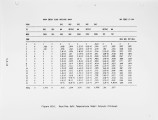| OCR Text |
Show As expected, the model curves in Figure 15 lie above the experimental curves. The difference in the predicted and experimental mass fraction breakthroughs is about two orders of magnitude. If the model is accurately predicting the carbon tetrachloride destruction in the postflame gases, then the destruction efficiency due to flame processes alone would be about 99 percent for these tests. 5.5 SUMMARY AND CONCLUSIONS Model development has been initiated to aid in the design, operation, and permitting of liquid-fired hazardous waste incinerators. The model can closely predict the bulk temperature measured in the pilot-scale tests. It revealed which operating and design variables strongly influence the temperature-time profile in the postflame region. The model further gave insights into those parameters which dominate postflame thermal oxidation of waste compounds cofired with distillate oil. The computer program, although limited by the size and speed of a microcomputer, has the potential to place conservative bounds on destruction efficiency in working incinerators. Several improvements should be made in the future. The foremost of these is based on the need for oxygen-dependent global rate expressions. When kinetic rate constants are available that describe oxidation and pyrolysis in furnaces at low excess air conditions (3 to 10 percent oxygen by volume), the model will be more likely to identify the optimum excess air level for destruction efficiency. The boundary layer destruction model needs to be verified by comparison with experimental data from detailed furnace probing. It may be necessary to upgrade the model by inclusion of a more detailed aerodynamic and mixing description. To simulate a broader range of combustor types, the effects of multiple burner geometries should be included. Further improvement in the chemical kinetic description could be added by extending the single-step global model to set off several semi-global reaction steps, with potential products of incomplete combustion as intermediates. When the necessary additions and refinements have been made, it will be appropriate to compare the model results to emissions from a full-scale liquid-injection furnace. 5.5.29 |

































